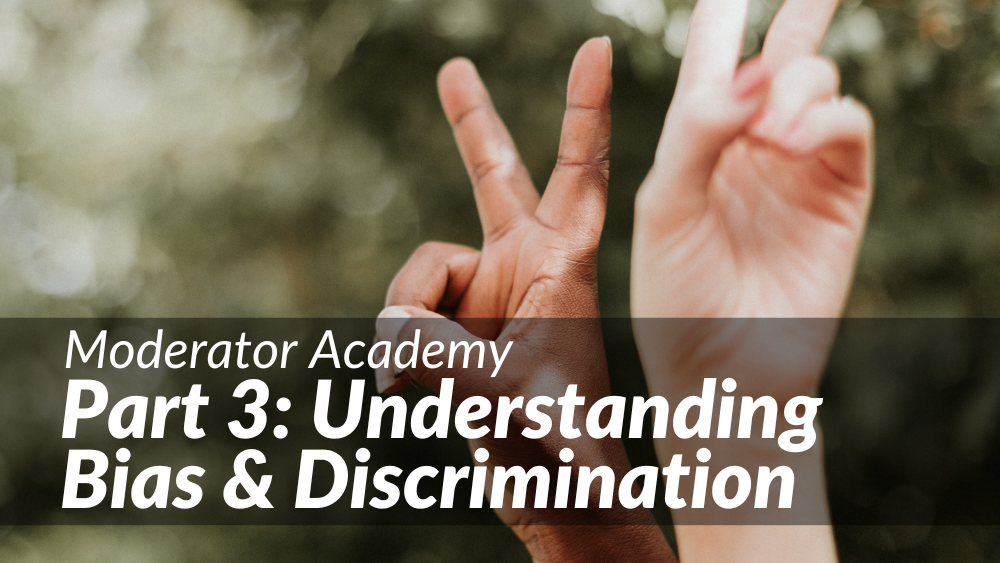Moderator Academy
December 15, 2022 · Last updated on April 30, 2025
Moderator Academy: Understanding Bias & Discrimination

# Moderation
# Community Guidelines
# Moderator Academy
Understand the role moderation plays in preventing and mitigating bias and discrimination in neighborhood conversations.

Team Nextdoor

Despite our best intentions, bias and discrimination can show up in our communities — often in places we’re least expecting it to. Nextdoor’s purpose is to cultivate a kinder world, where everyone has a neighborhood they can rely on. In order to do that, it’s important to understand the role moderation plays in preventing and mitigating bias and discrimination in neighborhood conversations.
What is bias?
Bias and discrimination work together hand-in-hand. Bias can be defined as a conscious or unconscious inclination of temperament or outlook, especially a personal and sometimes unreasoned judgment, and discrimination can be defined as the unjust or prejudicial treatment of different categories of people, especially on the grounds of race, ethnicity, gender, etc.
Every human has biases in some way or another. The ways in which each of us grew into adulthood shaped our viewpoints on the world, creating both conscious and unconscious biases. Conscious biases are things we're aware of, whereas unconscious biases are perceptions that take place without us even realizing they're happening.
Unfortunately our biases can cause harm towards others in the form of discrimination, whether we mean to or not. Each of us has a responsibility to understand and repair our own conscious and unconscious biases, to reduce discrimination and ensure an equitable world for everyone in the future.

(Image Attribution: Interaction Institute for Social Change | Artist: Angus Maguire)
Why is bias harmful?
Both conscious and unconscious bias can be incredibly harmful to others, especially those who happen to be part of a historically marginalized minority or group. At a minimum, biases often result in a verbal, behavioral, or environmental slight towards someone, known as a microaggression. Other cases of extreme bias have led to physical harm, and even the loss of life by those in the impacted group. This is why it's so critical to work to eliminate bias in our world.
Why are microaggressions harmful?
Microaggressions are harmful because they exclude or unfairly target a person based on their marginalized identity. Though a microaggression may not seem like a clear violation of Nextdoor's community guidelines, they can take a toll on the mental and physical health of the person, or group of people, on the receiving end. As a result, microaggressions are not appropriate for use in conversation on Nextdoor and use of them violates our Do Not Discriminate guideline.
🚨 Common microaggressions
Our goal is for you to be able to recognize microaggressions when used in conversation, understand their harm, and take informed, confident actions to ensure your neighborhood remains a welcoming place for everyone. Let’s discuss 5 common microaggressions:
- Stereotyping
- Tone policing
- Colorblindness
- Coded language
- Racial profiling
1️⃣ Stereotyping
Stereotyping happens when someone makes a broad assumption or generalization about a group of people.
The problem with stereotypes
The human brain unconsciously creates mental shortcuts, or generalizations, to help us quickly respond to situations. This feature of our biology was useful during earlier stages of our evolution, when we needed to react quickly to external environmental threats.
But we don’t live in that world anymore. For the most part, our homes are safe, society is stable, and we can generally rely on the care of our neighbors and public service agencies to maintain a balanced local community. The unconscious generalizations we make about other groups of people are both hurtful and harmful to people in those groups, and once these beliefs are created it can be very hard to change our way of thinking. Unconsciously viewing other groups of people as threats, or “less than” ultimately leads to discriminatory behavior.
2️⃣ Tone policing/ tone argument
Tone policing (also known as a tone argument) happens when someone argues about the tone, emotion, or manner in which an issue is presented, instead of its factual or logical content. In the context of racial bias, tone policing tends to show up when concerns of racism or discrimination are invalidated.
The problem with tone policing
There is clear, non-partisan data that shows bias related to race, gender, sexual identity, and other identity attributes is real, and regularly experienced. Tone policing reinforces stereotypes, invalidates and suppresses a person’s lived experiences, ultimately positioning them as “less than” to the majority group, preserves the majority group’s privilege, and ultimately removes the potential for a productive conversation where everyone is heard and respected.
3️⃣ Racial Colorblindness
Racial colorblindness happens when someone proclaims the absence of prejudice or discrimination on the basis of skin color or race.
The problem with racial colorblindness
Similar to tone policing, making statements that assert racial colorblindness invalidate someone’s lived experience and history, and suggest that racism isn’t real (despite clear, non-partisan data and historical information that proves otherwise.) Asserting racial colorblindness is also a way to disengage from the broader systemic conversation about racism, and avoid accountability for harm created by unconscious bias.
4️⃣ Coded language
Coded language describes the use of seemingly innocent words that have alternative, or offensive meaning, i.e.: thug, illegals, aliens, etc. They’re an indirect way to subtly indicate bias without explicitly stating, or being held accountable for the harm.
The problem with coded language
Coded language allows people to perpetuate harmful stereotypes in subtle, hidden ways, often without the stigma of explicit racism. This discriminatory behavior reinforces stereotypes, and drives further harm to communities of color through dehumanization.
5️⃣ Racial profiling
Racial profiling happens when race or ethnicity is used as grounds for suspecting someone of having committed an offense, either consciously or unconsciously. It is a form of discrimination, and can result in harmful consequences for innocent people, up to, and including, loss of life.
The problem with racial profiling
Suspecting someone of a potential offense based on appearance creates an unwelcoming, distrusting, and disconnected society. It does not improve safety in a local community, and can lead to post traumatic stress disorder (PTSD) for the targeted person. In some cases, loss of life can occur as a result of interactions that take place following the action of racial profiling (source.)
✊🏿✊🏾✊🏽Understanding Black Lives Matter
According to the Population Reference Bureau (PRB), Black people have the highest death rates of any of America’s racial and ethnic groups, in large part due to systemic inequalities in economic status, education, and occupation. (Source) In addition, data shows that a Black person is five times more likely to be stopped by police without just cause than a white person. (Source) We also know that Black people are 3.5 times more likely to experience fatal police violence in America than white people. (Source)
There is clear, non-partisan data showing the risks Black people face in living a long life in the United States, and intentional focus needs to be placed in order to improve these outcomes. The core message of the Black Lives Matter (BLM) movement is that Black lives are as valuable as any other human life, as there are many moments and statistics in our society that prove otherwise.
The Black Lives Matter movement has been conflated with partisan politics in recent years, and while it’s legitimate for neighbors to voice their opinions about political tactics (i.e.: defunding the police), attacking the Black Lives Matter movement in a general way gives the impression that Black lives do not matter as much as other lives in a community. This is why content that undermines the core message of Black Lives Matter is not appropriate on Nextdoor.
For more information on our policies pertaining to the use of Black Lives Matter, see the Support for Equality section of the Do Not Discriminate guideline: Support for Equality
🗣Talking about bias, race, and/ or discrimination on Nextdoor
Talking about bias, discrimination, race, and/ or racism are not inherently discriminatory acts. In fact, the only way we can move away from a system of bias and discrimination is by having conversations with one another about the impact discrimination has had. We want to empower neighbors to learn how to have these conversations in a productive way, so they help each other learn, heal, and ultimately drive society forward.
One of the best ways to approach conversations about race and the impact of racism is with an open mind and heart. When talking about race with neighbors, we recommend the following best practices:
- Check your temperature. It may not be easy to have conversations about race and discrimination. Be mindful of your own mental and emotional state, and wait until you feel calm and balanced to discuss.
- Listen. Be present with your neighbor, and listen intently to what they say even if it creates feelings of discomfort. Get curious about your own discomfort, before reacting to what your neighbor says.
- Recognize that it’s not about you. Nobody alive today created the power dynamic and system of racism and discrimination, though many people alive today both perpetuate bias, and experience hardship and barriers as a result. Avoid taking someone else’s experiences personally, because it’s not likely about you or about any specific thing you’ve done.
- Reflect on the conversation. Think about what you learned by listening to your neighbor. Put yourself in their shoes, and try to develop true empathy—the ability to understand and share the feelings of another person—for their experience.
- Decide what you'll do differently. Now that you’ve seen a piece of the world through someone else’s eyes, what will you do differently in the future? How will you change your own behavior?
Finally, it’s important to remember that you don’t have to engage in conversations about race and bias. Consider moving past the discussion if:
- You feel triggered by what has already been posted, and are not in a calm emotional state to respond thoughtfully;
- If what you’re going to say is not going to contribute to the conversation in a constructive way, or is not rooted in data or lived experience;
- If what you’re going to say is going to hurt someone (especially if they have a lived experience that is different from you);
- If what you’re going to say is not something you would be willing to say to a person face-to-face, in real life;
- You simply do not have the emotional bandwidth to educate or inform your neighbors.
For more support in having a hard conversation with neighbors, or supporting neighbors in having tough conversations with each other, see: Facilitating hard conversations: A kind guide
📝 Taking action on biased content
Now that we understand our individual responsibility in combating bias, have seen examples of some of the most common forms of unconscious bias and microaggressions, and have a toolkit to help neighbors have tough conversations, let’s learn how best to take action on these kinds of posts should you see them in your neighborhood. Scroll through the slides below for examples, response templates, and action steps.
⭐️ Check your knowledge
⏩ Next module: Reporting Content & Accounts
Now that you have an understanding of both the Community Guidelines, and how to recognize content that may potentially show bias against another neighbor, let's learn how to take appropriate action. Next module: Reporting Content & Accounts
Sign in or Join the community

Create an account
Dive in
Related
Resource
Moderator Academy: Understanding anti-Asian racism
By Team Nextdoor • Dec 15th, 2022 • Views 1.6K
Resource
Moderator Academy: Understanding anti-Asian racism
By Team Nextdoor • Dec 15th, 2022 • Views 1.6K
